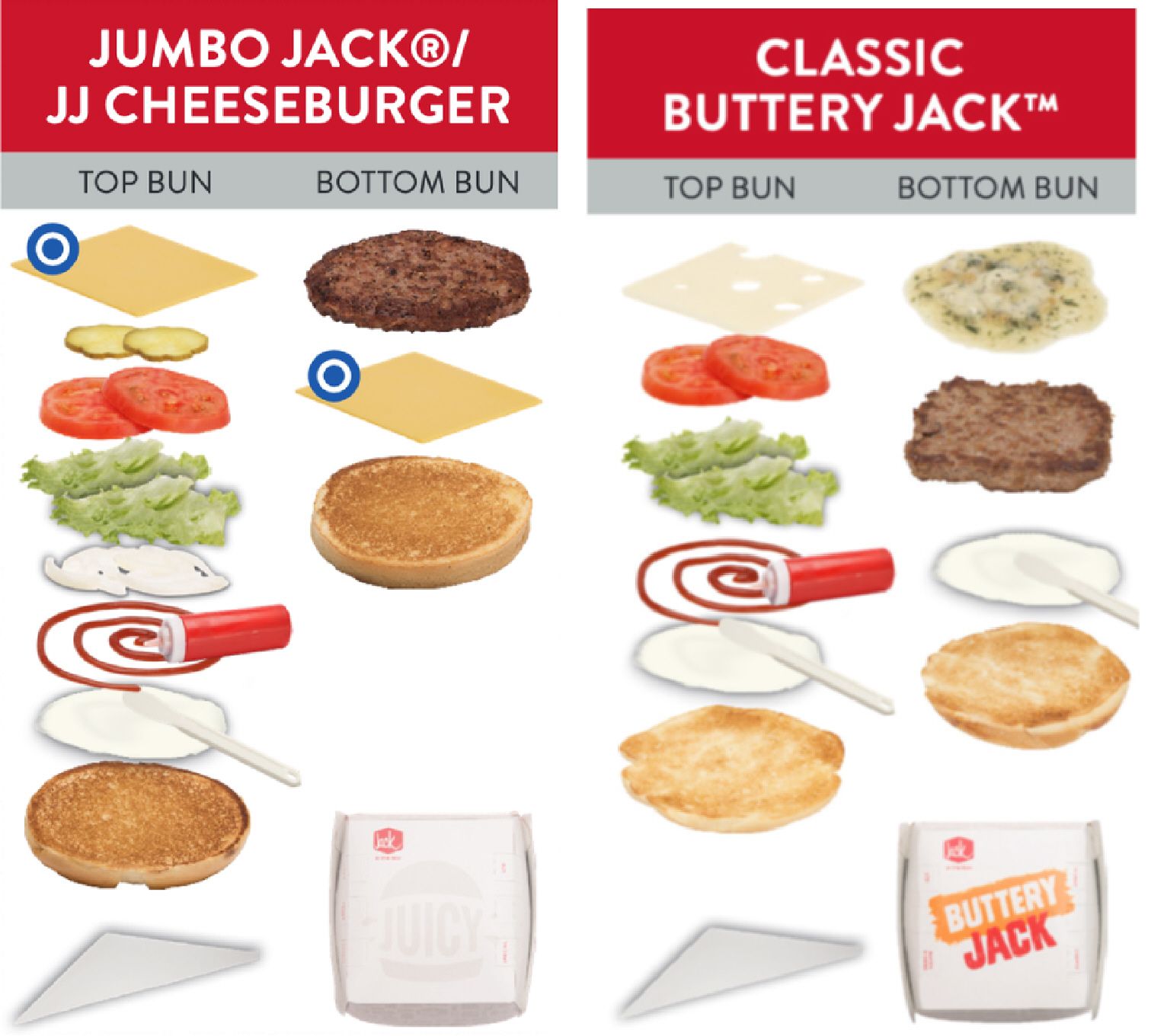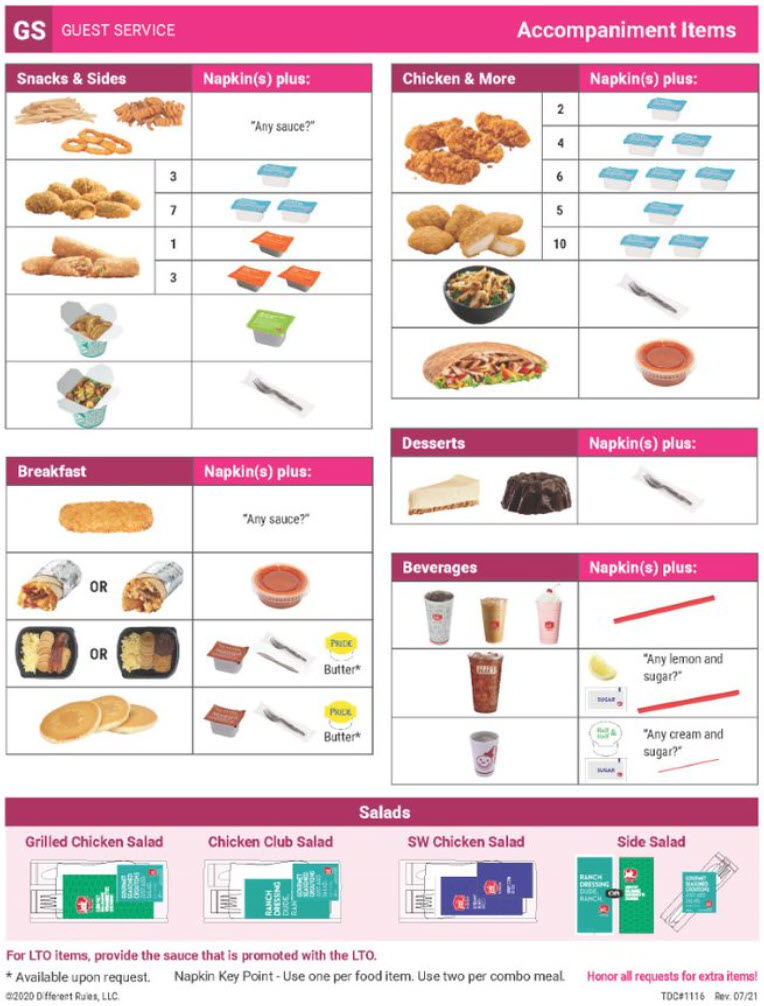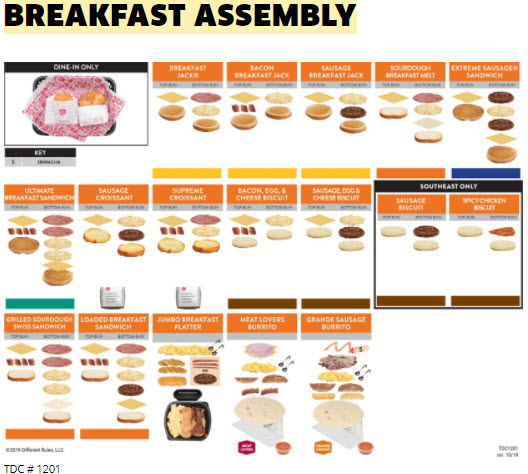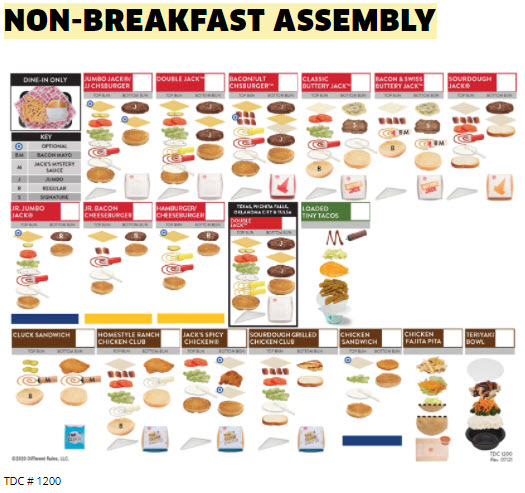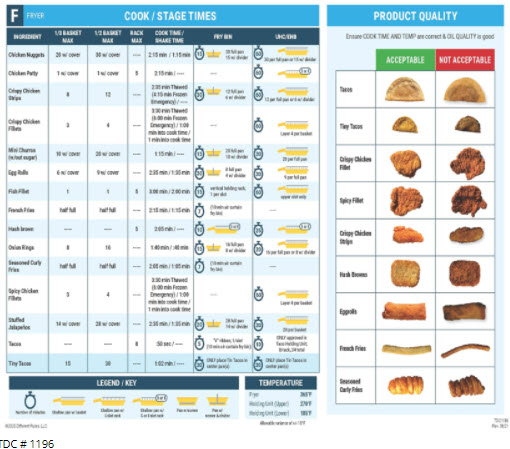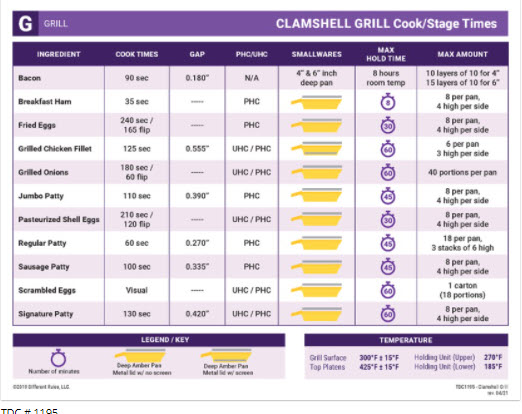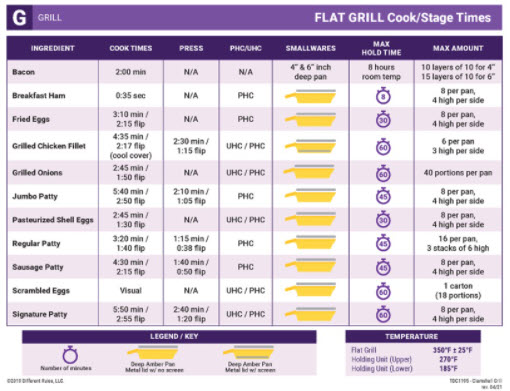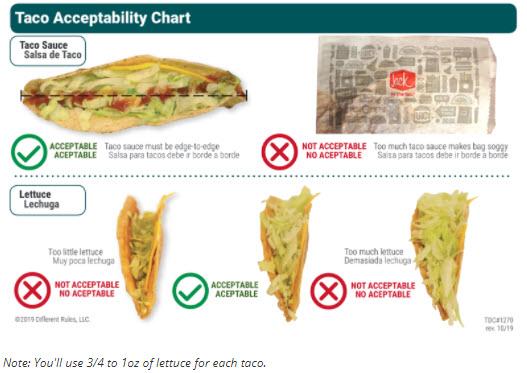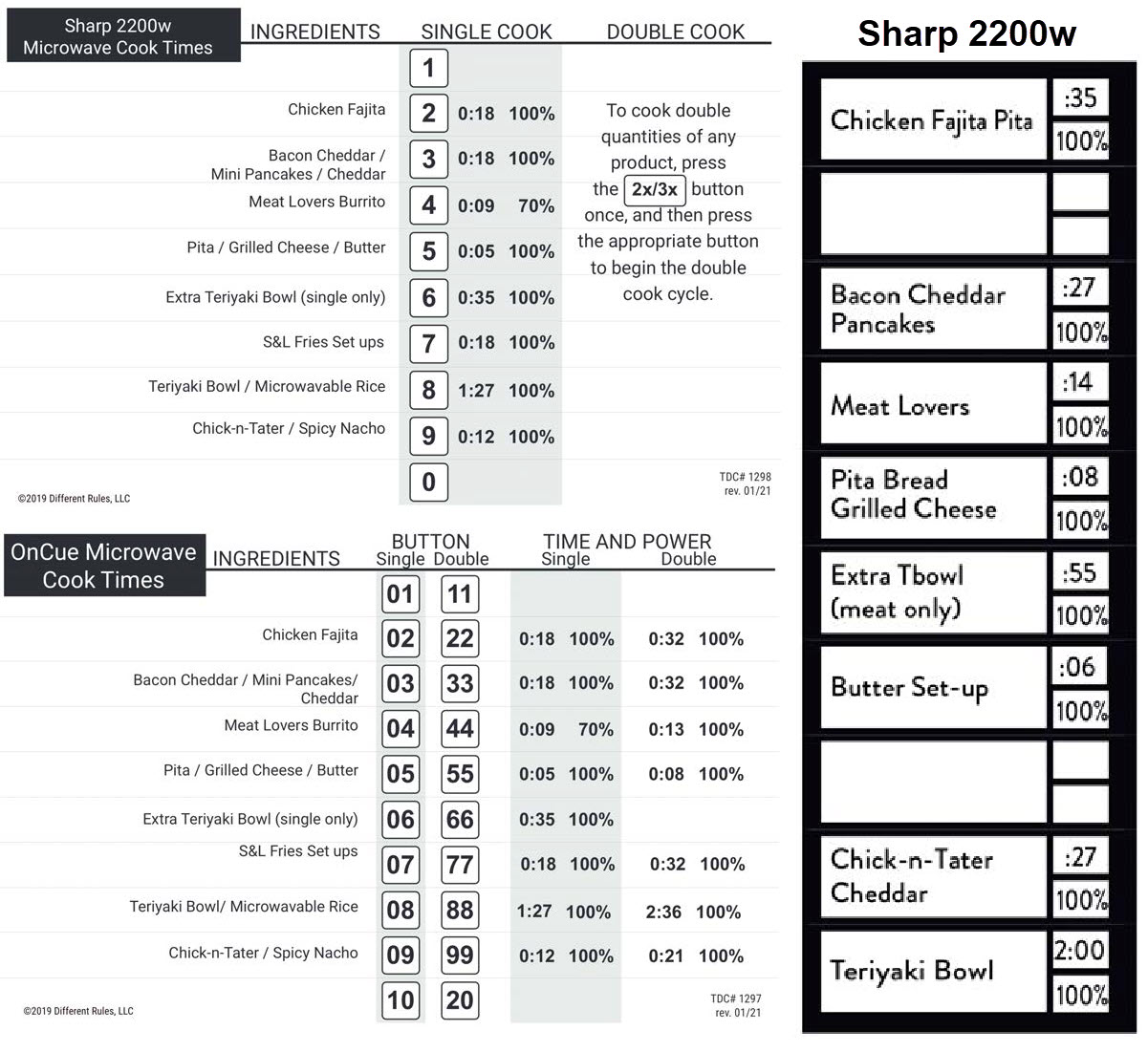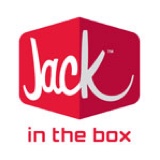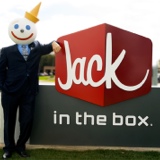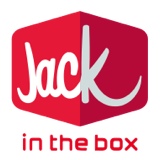Title Page
-
Site conducted
-
Conducted on
-
Prepared by
-
Location
-
GER
Assessment
undefined
-
Manager's Name
Guest Service
-
Guest greeted within 5 seconds of arriving in front of the Order Menu Board. If asked to hold, re-greeted in 15 seconds or less.
-
A. Greet time within 5 seconds of pulling up to the menu order board (order confirmation screen - OCS).
-
B. If asked to hold, re-greet within 15 seconds after being asked to hold.
-
Drive-thru Order Taker provides warm, friendly greeting and hassle free order taking.
-
A. Team Member greets Guest in a warm friendly manner at the Order Menu Board speaker or by the Outside Order Taker (OOT). Should sound enthusiastic, genuine, non-robotic without attitude, shortness or tone.
-
B. Conversation is hassle free: no language barriers or lack of training preventing smooth order taking process.
-
C. Order taker does not interrupt (multiple times) or rush Guest.
-
EXCEPTIONAL SERVICE AT ORDERING - Exceptional service.
-
A. Genuine, warm and friendly greeting provided. Can feel the smile and friendliness.
-
B. Is Highly Energetic and uses Exceptional Phrases.
-
C. Team Member is enthusiastic about the menu items.
-
D. It is evident that the Team Member clearly enjoys working at Jack in the Box and serving the Guests.
-
ORDER CONFIRMATION - Drive-Thru Order Taker confirms order using order confirmation screen (OCS).
-
A. Team Member confirms order is correct on the screen or fully repeats order for confirmation
-
DT ORDER CONFIRMATION SCREEN (OCS) & SPEAKER - Order confirmation screen (OCS) is clean
-
DRIVE-THRU WINDOW FRIENDLY SERVICE - Team Member warmly re-greets Guest at service window, makes eye contact, smiles and provides a 2-part thank you/farewell.
-
A. Immediately greeted at drive-thru window (within 10 seconds or less).
-
B. Team Member warmly greets Guest in a friendly manner at the Service window. Should sound enthusiastic, genuine, non-robotic without attitude, shortness, or tone.
-
C. Interaction is energizing and shows care for Guest. Body language shows Guest focus. Team Member makes eye contact and smiles during the interaction.
-
D. Team Member provides 2-part thank you/farewell.
-
SAUCES & CONDIMENTS OFFERED - Team Member specifically offered sauces/condiments as specified in Accompaniment Items Job Aid
-
A. Team member asks Guest if they would like any sauces for ordered items that don’t have a required recipe sauce/condiment.
-
B. Team Member automatically provides or specifically offers accompaniment condiments (sauce, dressing, salsa, etc.) by name for items that have required sauce/condiment
-
C. Team member automatically provides or specifically offers sauce/condiments that accompany LTO items.
-
BAG CONTENTS COMMUNICATION - Team member verifies and communicates the main contents of each bag to Guest as handed out, including special items.
-
A. The same Team Member that checks the bag for accuracy also communicates the bag contents to the Guest at drive-thru and front counter.
-
B. Team Member communicates the main combo items, including modifications, special requests when handing out the bag(s) to the Guest.
-
C. Bagged combos are repeated by main combo item name, not by combo numbers, including any modifications.
-
D. If the contents in the bag(s) is not a combo, all contents in the bag is repeated to the Guest, including any modifications.
-
RECEIPT PROVIDED - Guest provided a receipt without asking for one.
-
A. The correct/legible receipt is automatically provided to the Guest without the Guest having to ask for it.
-
EXCEPTIONAL SERVICE AT DT WINDOW - Exceptional service at drive-thru service window.
-
A. Team Member goes above and beyond in some way to connect with Guest and or provide exceptional, differentiated service.
-
B. Team member makes Guest feel truly appreciated for visiting this Jack in the Box.
-
C. It is obvious that the Team Member clearly loves their job and serving the Guest, the enthusiasm can be observed.
-
FRENCH FRIES - Hot, fresh, properly salted French Fries are assembled and served according to specifications and at the correct temperature.
-
Enter temperature
-
A. Temperature reading ≥ 150° Fahrenheit.
-
B. Salted - Fries have salted taste.
-
C. Texture - Taste is slightly crispy on the outside and soft on the inside.
-
D. Appearance - Fries appear golden brown: not overly dark or less than fully cooked. Fries hold form, not limp or soggy.
-
E. Portion - Bag is full/properly portioned.
-
Enter temperature
-
Burgers
-
BURGERS - Hot, fresh, juicy burgers served to specifications.
-
Beef patty temperature
-
A. Temperature - Beef patty temperature is ≥ 125°F.
-
B. Beef patty tastes juicy and fresh not dried out.
-
C. Fresh produce and ingredients are used.
-
D. Burger is neatly assembled, with correct ingredients, and order of build
-
Beef patty temperature
-
PACKAGING, BAGGING, SERVING - Guest order placed neatly in the bag and packaged to specifications.
-
A. Correct product tabs pressed to identify item.
-
B. Separate bags used for each combo and for custom orders.
-
C. Hot and cold items are in separate bags.
-
D. Food in bags should look neat (not more than 6 loose French fries in the bag).
-
E. Food boxes should be in good condition, closed, sealed correctly.
-
F. Food and packaging not smashed or coming apart.
-
G. Packaging or carryout bags should be free of excessive grease.
-
H. Condiments or dip cups are not torn, opened, or sticky on the outside.
-
I. Tamper proof stickers are properly placed on all delivery orders with receipt attached.
-
J. Tacos should be placed in bag correct side up.
-
Accompaniment items
-
CORRECT SAUCES & CONDIMENTS - Team Member provided Guest with the correct sauces/condiments.
-
A. Guest received correct sauces ordered and (or) per Accompaniment Job Aid TDC #1116.
-
B. Guest automatically received correct accompaniment condiments for all items.
-
C. Team Member provided additional or other sauces/condiments requested by the Guest.
-
D. Team member automatically provides sauce/condiments that accompany LTO items.
-
NAPKINS, UTENSILS, & STRAWS PROVIDED - Team Member provides napkins, utensils, and straws with order.
-
A. The order includes napkins, utensils, and straws as required (and except where prohibited).
-
3.8 Breakfast
-
3.8 Non-Breakfast
-
ORDER IS CORRECT - Guests receive the correct food and beverage order.
-
A. All items were provided were correct
-
B. All items include the correct ingredients.
-
C. Special/custom requests are made correctly.
-
SPECIAL REQUESTS CORRECTLY IDENTIFIED - Special requests/modifications are properly identified.
-
BEVERAGES - Beverages have the proper flavor, level of ice, carbonation, and beverage fill.
-
A. Flavor is to standard.
-
B. Correct carbonation.
-
C. Ice fill level to standard.
-
D. Lid is correctly secure and no spillage outside of beverage cup.
-
E. Desired beverage flavor is available.
-
Enter name of beverage ordered
BACK OF THE HOUSE - QUALITY
-
Fried Products
-
FRIED PRODUCTS HOLDING CABINET PROCEDURES - Holding Cabinet staging procedures meet specifications for all fried products.
-
A. Hold times are “on” for all held fried products.
-
B. All fried products are within proper hold time – no expired items.
-
C. Resetting times for held products not observed.
-
D. Based on visual observation ingredient(s) look fresh and meet quality standards
-
E. FIFO used to use oldest product first.
-
F. All fried products should have correct times programmed
-
G. All fried products are in correct slots to match programmed names (check all).
-
H. Correct quantities held in a single pan - i.e. 12 egg rolls per pan / 6 per side (check all).
-
I. Fried products are NOT held with a metal lid.
-
J. Fried products are staged/held correctly in drawers.
-
Clamshell
-
Flat grill
-
GRILLED PRODUCTS HOLDING CABINET PROCEDURES - Holding cabinet staging procedures meet specifications for all grilled products.
-
A. Hold times are “on” for all held grilled products.
-
B. All grilled products are within proper hold time – no expired items.
-
C. Resetting times for held products not observed.
-
D. Based on visual observation ingredient(s) look fresh and meet quality standards.
-
E. FIFO used to use oldest product first.
-
F. All grilled products should have correct times programmed.
-
G. All grilled products are in correct slots to match programmed names (check all).
-
H. Correct quantities held in a single pan (check all grilled products in holding cabinet).
-
I. Grilled products are held with a metal lid (check all).
-
J. Grilled products are staged/held correctly in drawers.
-
CRISPY CHICKEN - Crispy chicken is hot, crispy, juicy, and meets 'Quality' specifications. (Temp and evaluate one crispy chicken fillet, one spicy chicken fillet and one chicken strip from the holding cabinet)
-
A. Crispy Chicken Fillet is slightly crispy on the outside, fried to a golden brown color, is warm to hot on the inside <br> and moist / juicy. Temperature is 140°F or higher.
-
B. Spicy Chicken Fillet is slightly crispy on the outside, fried to a golden brown color, is warm to hot on the inside <br> and moist / juicy. Temperature is 145°F or higher .
-
C. Crispy Chicken strips are slightly crispy on the outside, fried to a golden brown color, is warm to hot on the inside <br> and moist / juicy. Temperature is 140°F or higher.
-
Crispy Chicken Fillet Temperature
-
Spicy Chicken Fillet Temperature
-
Crispy Chicken Strip Temperature
-
HOLDING CABINET TEMPERATURES - All holding cabinets maintain required temperature.
-
A. Long Stem Surface Prove Thermometer must be available to evaluate temperature of holding units.
-
FRY BIN - Fry bin (fried) items staging procedures meet specifications.
-
A. Hold times are “on” for all holding products.
-
B. All products are within proper hold time – no expired items (unless used for an order on the screen).
-
C. All products should have correct hold times programmed.
-
D. Resetting times for held products not observed.
-
E. FIFO practiced to use oldest product first.
-
F. Based on visual observation ingredient(s) look fresh and meet quality standards.
-
G. Products not stored in packaging unless there is an order on the screen for immediate use.
-
H. Products staged in correct smallwares and correct quantities.
-
Taco
-
TACOS - Hot, fresh, and crispy tacos fried, assembled, and staged per specifications; taco station maintained for quality and quick.
-
A. Tacos not held past hold time
-
B. Correct hold times are programmed and in use to ensure 5 minute hold time in the fry bin.
-
C. Once fried, rack tilted sideways for 5 to 10 seconds to allow excess oil to drain into fryer (and minimize <br> greasiness of tacos).
-
D. Taco packaging is clean and presentable (free of excessive taco sauce or grease).
-
E. Tacos are not served with broken shells or cracks greater than 1 ½".
-
F. Tacos are sauced edge-to-edge.
-
G. Shredded lettuce on assembled Tacos is portioned correctly (3/4 ounces to 1 ounce). Refer to visual on the Taco <br> Acceptability Chart (TDC# 1270).
-
H. Shredded lettuce at Taco Assembly station is fresh, crisp, and dry.
-
I. Only thoroughly defrosted tacos are fried.
-
J. Fried in correct fry rack.
-
K. Taco assembly rack in place and used for lettuce, cheese portioning, assembly of tacos.
-
FRIED PRODUCTS - DRAINING & REMOVING - Fried products are properly drained and removed to ensure quality and presentation.
-
A. After fry cycle, baskets are gently shaken to drain the oil from the products.
-
B. Fried products are immediately packaged or staged and not left in fry baskets or racks.
-
C. Fried products are transferred with tongs. Ingredients are not dumped directly into packaging to prevent <br> excessive oil from getting onto packaging.
-
D. French fries are properly salted.
-
OIL QUALITY - Oil quality maintained to ensure fresh tasting fried products.
-
A. Skimming – fryer oil skimmed as needed to prevent oil degradation and remove particles from sticking to other <br> products that are being fried.
-
B. Smoking Oil – oil not smoking excessively, which often indicates expired oil.
-
C. Oil Temperature at 365° +/- 15°F. Evaluate at least one vat using the restaurant’s infrared thermometer or an <br> immersion probe.
-
D. Oil Level – oil quantity is at approximately the correct level as indicated by the min/max lines in the fry vats.
-
E. Equipment being maintained – clear evidence of ongoing filtering, cleaning, and heavy carbon removal.
-
PREPPED ITEMS READY FOR "GRAB & PLACE" - All prepped items at the assembly line meet quality and are ready for "grab & place".
-
A. Prep items are ready for "grab and place" for Assembly Team Member.
-
B. Quality to standard – team member does not have to sort through or discard unacceptable product.
-
C. Slice tomatoes are stacked flat, not sideways to protect slice integrity.
-
D. Ingredients not filled higher than fill line on pans.
-
BREADS - Buns stored, handled, buttered, and toasted to specifications.
-
A. Split Top and Regular buns, are held in closed / sealed bags – except for what is being used for current shift / <br> next hour.
-
B. Buns are not smashed after toasting.
-
C. Buns are toasted to order, not staged at/or near toaster if no orders appear on the kitchen (KDS) monitor.
-
D. Proper buttering procedure followed with BFVO (Butter Flavored Vegetable Oil).
-
E. Teflon sheet in the contact toaster is free of buildup and in good condition.
-
F. Split Top and Regular buns are toasted with a full and even coat of butter applied, 80%+ of surface toasted to a <br> golden brown, not burnt, bun not smashed after coming out of contact toaster.
-
BREADS - BRIOCHE, CROISSANTS, & BISCUITS - Brioche, croissants, and biscuits are stored, handled, buttered (only biscuits), and toasted to specifications.
-
A. Brioche buns, croissants, and biscuits, are held in closed / sealed bags – except for what is being used for <br> current shift / next hour.
-
B. Buns/breads are not smashed after toasting.
-
C. Buns should be toasted to order, not staged at/or near toaster if no orders appear on the kitchen (KDS) monitor.
-
D. Batch toaster spatula is stored under crumb tray when not in use.
-
E. Bread items are toasted to standards.
-
BREADS - SOURDOUGH - Sourdough bread is stored, handled, buttered, and toasted to specifications.
-
A. Sourdough bread is held in closed / sealed bags – except for what is being used for current shift / next hour.
-
B. Sourdough bread is not smashed after toasting.
-
C. Sourdough bread is toasted to order, not staged if no orders appear on the kitchen (KDS) monitor.
-
D. Teflon sheet in the bread griller is free of buildup and in good condition.
-
E. Proper buttering procedure followed with BFVO (Butter Flavored Vegetable Oil).
-
F. Sourdough bread slices are buttered and toasted to standard.
-
SAUCING EDGE-TO-EDGE - Saucing on sandwiches is 'edge-to-edge'.
-
A. Saucing is evenly spread from edge-to-edge of breads and buns.
-
B. Mayonnaise is evenly spread across bun or bread.
-
C. Sauce bottles on line have correct tips
-
Microwave
-
MICROWAVE - Microwave cook times are used correctly.
-
A. Team members pressing correct buttons to fully melt/cook ingredients.
-
Grilled Products are cooked to specifications
BACK OF THE HOUSE - QUICK
-
RUSH READY - TEAM - Team and restaurants are rush ready and in primary positions to support peak volumes. Daily planners are posted, used, 4+ headsets in use.
-
A. Team Workstation Daily Planners in place and in use.
-
B. ‘All hands-on deck’ in guest service positions during peak periods
-
C. 4+ headsets are in use (PIC, Fryer, Grill, and drive-thru Team Member) or BOH kitchen drive-thru speaker is on and can be <br> clearly heard.
-
BUILD-TO CHARTS - Precooking/staging/build-to in place including posting, adjusting, and using build-to charts
-
A. Build-to and precooking are in place. Cook to order practices are generally not observed, except for zero <br> items on the Build-to charts.
-
B. Team members using build to chart system – pre-cooked amount of product on build to chart are staged in <br> holding cabinets and fry bins.
-
C. Build-to charts are posted for correct day and daypart. Adjusted if applicable.
-
D. "Stop and Drop” is used for “zero” items within 30 seconds of being ordered by guest or instructed by PIC or <br> Guest Service Team Member.
-
BUILD-TO CHART & STAGING TEAM MEMBER KNOWLEDGE
-
A. Grill or Fryer Team Member can explain build to and staging procedures.
-
To evaluate – ask the questions below:
• How do they use build-to charts and correctly stage product?
• Why is using the build-to important? -
STOP & DROP TEAM MEMBER KNOWLEDGE
-
A. Grill or Fryer Team Members can explain when to stop and drop and ‘zero’ items.
-
To evaluate – ask the question below:
• What do you do when a "zero" item is ordered by a Guest? (Item not populated to be precooked and staged on build-to report.) -
FULLY STAFFED WITH PROFICIENT TEAM - Restaurant shift is fully staffed with proficient Team Members to achieve all Brand Standards.
-
A. Team should be staffed to effectively take, make, or serve majority of orders within Quick standards. (Refer <br> to kitchen display screen to evaluate Order to Delivery times. (Few to no orders should be more than 6 <br> minutes).
-
B. Guests are not put on hold.
-
C. Team Members are proficient in their primary positions to achieve Guest Quick times and maintain clean <br> standards. Allow for training of a new Team Member. However, the Team Members currently working the <br> shift should be proficient with a sense of urgency and minimal mistakes or confusion.
-
WORKSTATION POSITIONING - Workstation position principles (deployment) and Guest priority sequence in place to enable 'Quick' and Guest standards.
-
A. Team members are Guest focused and slide deploying - Team Members getting orders out for Guests before completing other duties. Team slide deploys to help one another get each order completed quicker and balance their workload.
-
B. Workstation Chart is posted for current day and daypart.
-
C. Deployment on Workstation Position Chart is assigned in consecutive order without skipping any numbers
-
D. Team Members are working their designated positions.
-
PIC LEADING TEAM - PIC is actively leading the shift and team to achieve 'Quick' and Guest Experience standards
-
A. PIC is in 'manager zone' – this means being in primary positions of #3, #5, or #7 at least 75% of the time to maximize leadership impact.
-
B. PIC can be seen and heard leading this shift.
-
C. PIC Daily Planner is current, posted, and in use during the shift.
-
D. PIC is observed verifying (verbally or visually) build-to levels during the shift.
-
E. PIC observed completing or ensuring the Guest Expectation Travel Path gets complete at least once during the review.
-
F. Role models/monitors cash handling procedures (employee meals, voided orders, item cancels, one person per drawer, large bills)
-
G. Can pass Food Safety audit
-
PIC LEADERSHIP KNOWLEDGE QUESTION
-
A. Tell me how you lead a shift to ensure a consistently great Guest Experience?
-
B. Tell me, how do you handle Guest complaints?
-
ALL TEAM MEMBERS, INCLUDING PIC ARE IN GUEST READY UNIFORM
-
A. All employees have complete and approved uniform
-
B. Uniforms are clean, free of stains and excessive fading or damage
-
C. Uniforms fit proper;y (not too tight or too loose)
-
D. Jackets or sweaters are Jack beanded or solid black or gray (unbranded)
-
E. Name tags are correct and visible - even if wearing an apron, jacket or sweater
DINING ROOM - CLEAN
-
DINING ROOM - CEILING VENTS, & LIGHTING - Dining room ceiling tiles, vents, and lighting is clean
-
A. Ceiling vents are clean.
-
B. Lighting clean
-
DINING ROOM - WALLS & DÉCOR - Dining room walls and décor are clean
-
A. Walls (to include) exterior fireplace walls) are clean
-
B. Décor is clean
-
DINING ROOM - WINDOW LEDGES, SILLS, & BLINDS - Dining room window ledges, sills, and blinds are clean
-
A. Window sills/ledges are clean
-
B. Blinds are clean
-
DINING ROOM - FLOORS - Dining room floors, corners, and areas under tables, covings, baseboards, and mats are clean; wet floors signs are clean, used only when floor is wet.
-
A. Floors, corners, areas under tables, covings, baseboards, and mats are clean, free of buildup.
-
B. Wet floor signs are clean. Being used appropriately and not left out after floors are dry.
-
C. Spills are quickly addressed.
-
DINING ROOM - TABLES, CHAIRS, & TRASH RECEPTACLES - Dining room table, seats, highchairs, dividers, and trash receptacles are clean. Trash receptacles not full.
-
A. Tables are clean (no more than 3 dirty tables for longer than 5 minutes).
-
B. Dining room seating, chairs, and high chairs are clean. Minimum of 2 high chairs are available.
-
C. Table and chair legs are free from buildup.
-
D. Dining room dividers are clean.
-
E. Trash receptacles are clean, and not full or overflowing.
-
FRONT COUNTER AREAS - Menu board, front counter drink, and condiment stations stocked and are reasonably clean
-
A. All front counter Point of Purchase (POP) is clean, current (no hand- written or unapproved typed signs).
-
B. Menu board is fully lit, clean.
-
C. Front counter Point of Sale (POS) elements and monitors are clean, free of dust buildup.
-
D. Drink machine and condiment stations are reasonably clean.
-
E. Drink machine and condiment stations stocked
-
BACK OF THE HOUSE & KITCHEN VIEW - Kitchen view of back of house is clean, organized, and with minimal internal guest facing team messaging.
-
A.The kitchen appears clean, organized, and clear of unnecessary clutter from Guest view.
-
B. Guest facing posted job aids are minimal (less than 5), legible, clean, and relevant to positions.
-
DINING ATMOSPHERE & AMBIANCE - Dining atmosphere and ambiance are comfortable, dining room is free of abnormal odors.
-
A. Temperature (not unreasonably warm or cold).
-
B. Music (not missing, too low, or too loud).
-
C. Clean smell – no abnormal odors.
-
D. Team Member dialogue professional – not overly loud, disruptive to Guest experience.
-
RESTROOMS - Restrooms are clean, stocked. All fixtures, mirrors, sinks, toilets, soap dispensers and paper towel holders / hand dryers are clean.
-
A. Restrooms are clean and free of buildup on floors, doors/kick plates, fixtures, sinks, toilets/ urinals, walls, partitions, etc.
-
B. Restrooms are properly stocked (soap, towel dispensers, toilet paper).
-
C. Trash receptacles are clean, lined, and not overflowing.
-
D. All lighting is clean.
-
E. Sanitary receptacles in place (if applicable), clean and not overflowing.
-
F. Restroom mirrors and frames are clean.
-
G. Restrooms ventilation/fan covers are clean.
-
H. Handwashing job aid (TDC#1041) is posted.
EXTERIOR - CLEAN & CONDITION
-
EXTERIOR SIGNAGE & LIGHTING - All exterior brand signage, lighting clean.
-
A. All exterior signage (to include: directional signage, handicap signs, parking stall signage, building and monument signage) is reasonably clean, free of stains and buildup.
-
B. All exterior poles and support items connected to signage is clean.
-
C. All lighting is turned on after dark (including any signage lighting).
-
D. No handwritten or unapproved typed signs in Guest view unless allowed by brand.
-
EXTERIOR POP - Exterior POP elements are current, clean, in good condition, not faded, and correctly applied.
-
A. All POP is current, clean, and in good condition, free of fading, bubbles, and pealing corners.
-
RESTAURANT EXTERIOR - Building exterior walls, roof, reasonably clean. 3 or fewer total minor individual items can be missed. Note: Standard will not be met if ONE MAJOR OR EXTERME issue is observed.
-
A. Building exterior walls are reasonably clean and in good condition (i.e. free of buildup, grime, or splatters).
-
B. Back door(s) are reasonably clean and in good condition. Back door area clear of pallets, bread racks, or miscellaneous items.
-
C. Exterior building roof, awnings, fascia, mansard, soffit, rain gutters, and down spout reasonably clean, in good condition, and free of bird’s nests.
-
D. Perimeter fencing reasonably clean.
-
DOORS, WINDOWS, & LEDGES - Doors, windows, and ledges all around the building are clean.
-
A. Doors, door frames, push bars, and thresholds reasonably clean
-
B. Back doors are closed when not in use
-
C. Windows and exterior window ledges all the way around the building are reasonably clean.
-
D. Entry door is not over cluttered with POP, clings, signage.
-
PARKING LOT - Parking lot is clean
-
A. Parking lot is clean. Four or fewer total of the following: pieces of trash, spills/messes, and also 4 or fewer total cigarette butts and 4 or fewer gum buildup.
-
SIDEWALK, PATIO, & EXTERIOR FURNITURE - Sidewalk, patio, and exterior furniture are clean.
-
A. Four or fewer pieces of trash, cigarette butts, or buildup areas (grime, stains, unscraped gum buildup) on sidewalk areas all around the building, including patio areas and furniture.
-
B. Wet floor signage or cones in Guest view are in active use (not left out on dry surfaces).
-
EXTERIOR TRASH RECEPTACLES - Trash receptacles, not full.
-
A. Exterior trash cans/receptacles and cigarette receptacles are not full, overflowing.
-
B. Trash cans/receptacles are reasonably clean and free of grime.
-
LANDSCAPING - Landscaping area is reasonably clean.
-
A. Landscaping reasonably clean.
-
B. Four or fewer total pieces of trash throughout all landscaping areas.
-
C. Minimal to no cigarette butts (10 or fewer) in one area such as the drive-thru menu board landscaping area.
-
DRIVE-THRU PREVIEW BOARD - Drive-thru preview board and all components are clean, free of buildup
-
A. Drive-thru preview board and components are reasonably clean (plexiglass, T-bars/dividers, hardware, metal plastic, numbers, etc.).
-
B. Free of excessive dust/dirt, buildup, stains, stickers, or gum.
-
C. Menu Panels, T-bars/dividers, numbers are straight, not crooked.
-
DRIVE-THRU ORDER MENU BOARD - Drive-thru menu board and all components are clean, free of buildup.
-
A. Drive-thru order menu board, confirmation screen, speaker, and all other components are reasonably clean (plexiglass, T-bars/dividers, hardware, metal plastic, numbers, etc.).
-
B. Menu boards are illuminated after dark.
-
C. Free of excessive dust/dirt, buildup, stains, stickers, or gum.
-
D. Order menu panels, T-bars/dividers, numbers are straight, not crooked.
-
DRIVE-THRU LANE & CURBS - Drive-thru lane and curbs clean.
-
A. Three or fewer pieces of trash, spills, stains, soil/grease buildup in the drive-thru lane, cement, asphalt, and curbs.
-
B. Drive-thru lane, cement, asphalt, and curbs are free of weeds, and excessive (10 or fewer) unscraped gum buildup.
-
DRIVE-THRU SERVICE WINDOW - Drive-thru service window area clean. Evaluate for 3 or fewer minor issues of dust, adhesive residue, spills, or stains.
-
A. Drive-thru windows, window frames, window ledges, and POP hardware is clean.
-
B. Wall area around and cement area below service window are clean.
-
C. No handwritten or unapproved typed signs.
TRAINING & KEY SYSTEMS IN PLACE
-
TRAINING & CERTIFICATION - Management and Team trained and certified on required brand standards.
-
A. Training tablet is charged.
-
B. Training system in place to certify Team Members on brand operating standards.
-
C. Certified Team members know the correct standards and are certified for proficiency.
-
D. PIC can show proof of certification in training system for Team Members working the shift.
-
E. PIC or Team Member can correctly explain training process or refer to Jenius.
-
PROMOTION TRAINING & CERTIFICATION - Current Promotion Training and Certification to specifications.
-
A. Team Members demonstrating correct behaviors and execution of new products.
-
B. Team Members have been certified in Jenius for current promotion.






